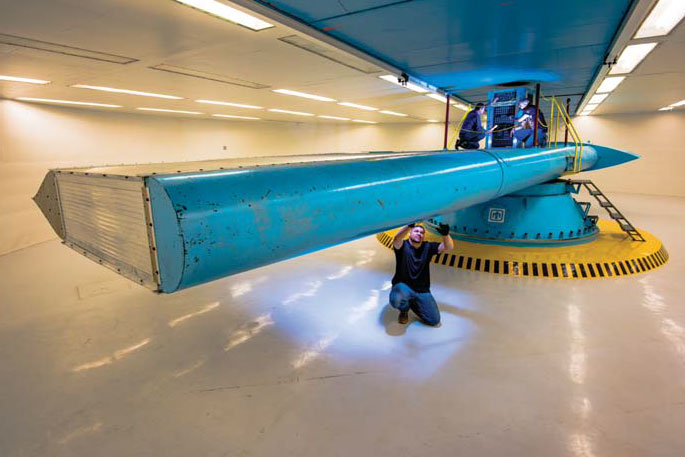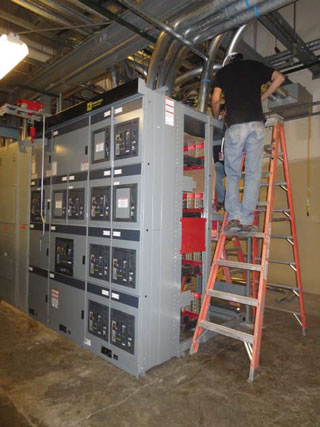
In March 2014, the Test Capabilities Revitalization (TCR) Phase 2 achieved its final project milestone, finishing work begun in 2005. TCR Phase 2 addressed critical infrastructure and equipment needs in 26 facilities, including the 10,000-foot sled track facility, the largescale centrifuge facility, the mechanical shock facility, and the two large-scale vibration facilities. Per NNSA, the project met all of its performance goals related to cost, schedule, and scope and was completed $9.1 million under the approved total project cost budget. NW [NW]
Bldg. 730 was built at the intersection of 9th Street and K Ave. in Tech Area 1. It was the third of five institutional assets constructed with Integrated Mission Support funding, per an FY12 agreement by the Laboratories Leadership Team. It incorporates lessons learned from Bldg. 704. Construction ran from August 2013 to July 2014. The building provides offices and light laboratory space to benefit ongoing science and technology activities, major S&T program initiatives, and multiple mission elements. The project was completed within budget, on schedule, and with zero safety incidents. (2900, 4200, 4800, 9300, 10200) IMS [LF]
An ongoing project to replace the existing evaporative coolers with refrigerated rooftop air conditioners for Bldg. 963 was combined mid-project with a task to prepare the building for the installation of a new test chamber used for electrostatic discharge experiments. Work on both projects Partnerships & alliances Sandia and the University of New Mexico’s jointly developed protocell technology was licensed to startup Alpine Biosciences in July 2014. Oncothyreon Inc. subsequently acquired Alpine Biosciences in August. The license and acquisition will accelerate the technology’s clinical development for treating currently intractable diseases. UNM led licensing for cancer therapies while Sandia retains rights to seek partners for national security applications. Sandia and UNM will share in any royalties that result from successful commercialization. The Sandia-UNM relationship is a partnerships model Sandia will replicate with other university partners to increase IP deployment. (1900) IHNS [RGCBD] was sequenced and protective structures were provided to allow users to continue their mission work with minimum disruption. Both projects were completed on time and more than $100,000 under budget. (4800) NW [NW]

The Facilities Management and Operations Center (FMOC) executed significant, complex, and highly accelerated projects to replace outdated electrical equipment (switchgear and panel boards) leading to the major utility and building systems for several buildings in Tech Area 1. Since the electrical equipment could no longer be adequately maintained, the renovations were completed to help reduce the risk of major unplanned and extended utility outages that could affect mission work. The project also improved the safety of electrical equipment, including a reduction in arc-flash hazard potential. (3000, 4000, 6000, 10000) IMS [LF]
The Facilities Management and Operations Center’s Fire Protection and Assurance Dept. 4879 recently developed the fire protection requirements contained in Sandia’s new ChemPro application. This Oracle storefront purchasing application establishes a control point for the purchase of chemicals and helps ensure compliance with numerous federal, state, local, and corporate requirements. To ensure chemical quantities comply with applicable fire code requirements, the ChemPro application interfaces with the FMOC’s Maximum Allowable Quantity tool. FMOC fire protection engineers review all chemical requests for fire protection compliance and approval. (4800) IMS [LF]
Facilities’ Partnership and Planning Dept. 4853 and Earth System Analysis Dept. 6926 developed Sandia’s Institutional Transformation (IX) model, a tool that evaluates energy conservation and solar renewable energy projects at both the building and campus level. The IX system links a series of models to evaluate more than 30 energy conservation measures across building types (for example, labs and offices), technical area, or time. Sandia is using the IX model to inform capital funding and policy decisions. (4800, 6900) IMS [LF]
The Videoconferencing and Collaborative Technologies team initiated an effort to improve customer experience using state-of-the-art technology. The infrastructure was redesigned to allow more fluid integration with internal and external customers. Ten public videoconferencing rooms across Sandia were upgraded to take advantage of the new infrastructure, which meets the Videoconferencing Common Operating Environment. The rooms are equipped with high-resolution LCD displays and easy-touse handheld remotes. Public rooms continue to be upgraded in FY15 and we’re working with private room owners to upgrade to the same technology. (8900) IMS [LF]
The Sandia/New Mexico Technical Library provided significant contributions to DOE’s Scientific and Technical Information Program. Transitioning to web services, more than 13,000 scientific and technical information items emanating from Sandia were submitted to the program. Sandia is the first laboratory to complete this transition, establishing a modern, efficient process for current and future submissions, while setting the bar high for other national laboratories to follow in ensuring a comprehensive Scientific and Technical Program is in place for their sites. (9500) IMS [NW]
Significant progress implementing the Sandia/California Site Development Plan was made in FY14. Among Facilities’ projects completed are: C912 North Wing second floor was modernized for future use; C905 was seismically retrofitted for personnel safety; C927 was demolished, removing substandard space; multiple building mechanical equipment and associated control systems were refurbished for efficient use; the west side parking lot was renovated for enhanced safety; and the Livermore Valley Open Campus entrance was established for visitors. (8100, 8200, 8300, 8500, 8600, 8900) IMS [LF]